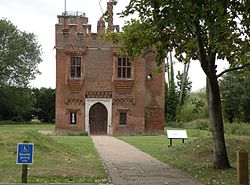Rye House, Hertfordshire
| Rye House | |
| Hertfordshire | |
|---|---|
 The gatehouse of Rye House | |
| Location | |
| Grid reference: | TL38570995 |
| Location: | 51°46’16"N, -0°0’25"E |
| Town: | Hoddesdon |
| History | |
| Built 1433 | |
| For: | Sir Andrew Ogard |
| Information | |
| Condition: | Ruined: gatehouse remains |
Rye House is the ruin of a former fortified manor house by the eastern border of Hertfordshire, infamous in history.
The house stands in ruin near Hoddesdon. The gatehouse is the only surviving part of the structure in any substance and is a Grade I listed building.[1] It is found on the eastern side of the canalised River Lea, in what is now the Lee Valley Regional Park, close to where the River Stort joins the Lee. Today its location is less salubrious than when the house stood, being on the edge of a giant sewage works in one direction, and the edge of Hoddesdon across the river on the other.
The Hertfordshire Border Walk passes Rye House.
The house gave its name to the Rye House Plot, an assassination attempt of 1683 that was a consequence of the Exclusion Crisis in British politics that raged from 1679.
History
Andres Pedersen, a Danish soldier who took part in the Hundred Years' War, was denizenised in England in 1433, becoming Sir Andrew Ogard.[2] In 1443 he was allowed to impark part of the manor of Rye, the area then called the Isle of Rye, in the parish of Stanstead Abbots, and was given licence to crenellate what became Rye House.[3] Over 50 types of moulded brick were used in its construction.[4]
Early modernity
In 1517 Rye House was the home of William Parr, father of Henry VIII's sixth wife, Catherine Parr;[5][6] It passed in 1577 to Joyce Frankland from her husband William.[7] The Frankland family sold it to the Baeshe family, in 1619.[3]
In 1676, Edmund Feilde, the Member of Parliament for Hertford, bought the house.[8]
In 1683, this was the setting of the Rye House Plot. At that time it was the home of Richard Rumbold, one of the conspirators.[9] The plotters planned to ambush the King and his brother James Duke of York as they passed Rye House on their way to Newmarket, and to slay James and possibly the King himself, but their scheme was exposed. Rumbold fled the country (and was hanged for his part in Argyll's Rising in 1685).
From the 19th century
By 1834 Rye House had become a workhouse. Subsequently (William) Henry Teale developed it into a tourist attraction,[10] buying the House and 50 acres in 1864.[3] There were a maze and a bowling green, among other features.[11] An affray there in 1885 between Roman Catholic excursionists and Orangemen led to a question in the House of Commons.[12] In 1911 it was described as a hotel.
For many years the Great Bed of Ware was on display.[13]
The moat was put to uses including growing water cress.[11] A popular music hall song of the late nineteenth century celebrated it:
"Oh! It really is a wery pretty garden
And Rye'ouse from the cock-loft could be seen
where the chickweed man undresses
to bathe 'mong the water cresses
If it wasn't for the 'ouses in between.."[14]
Geography
The local geography played a significant part in the history of the House. At Hoddesdon the River Stort runs into the River Lea, and the area was often flooded. The lord of the manor of Rye maintained a bridge over the Lea, and a causeway. The causeway became part of the coaching road via Bishop's Stortford into East Anglia.[3]
-
Engraving from 1777, showing the gatehouse brickwork before restoration. By 1795 some of this brickwork had gone.
-
View from the road (1777 engraving), facing south-west
-
Rye House, 1823 engraving. The long building was a barn and malting-house, then used as a workhouse
-
Poster from around 1880, advertising excursions to Rye House from London terminuses
-
Engraving by Edmund Hort New (1897 edition of The Compleat Angler
Outside links
| ("Wikimedia Commons" has material about Rye House, Hertfordshire) |
References
- ↑ National Heritage List 1341877: Rye House Gatehouse
- ↑ Dorothy J. Clayton, The Administration of the County Palatine of Chester, 1442–1485 (1990), p. 64; Google Books.
- ↑ 3.0 3.1 3.2 3.3 A History of the County of Hertford - [http://www.british-history.ac.uk/vch/herts/vol3/pp366–373 Volume 3 pp 366–373: 'Parishes: Stanstead Abbots' (Victoria County History)]
- ↑ Anthony Emery, Discovering Mediæval Houses (2008), p. 78; Google Books.
- ↑ Template:ODNBweb
- ↑ Porter, Linda (2010). Katherine the Queen: The remarkable life of Katherine Parr. Macmillan. p. 44. ISBN 978-0-230-71039-9.
- ↑ Template:ODNBweb
- ↑ Anthony Emery, Greater Mediæval Houses of England and Wales, 1300–1500: East Anglia, Central England, and Wales (2000), pp. 289–91; Google Books.
- ↑ Template:ODNBweb
- ↑ National Monuments Record: No. 367226 – Rye House
- ↑ 11.0 11.1 Walford, Edward: 'Greater London: a narrative of its history, its people and its places'
- ↑ Hansard HC Deb 20 July 1885 vol 299 cc1194-5.
- ↑ Karl Baedeker (Firm), London and its Environs; handbook for travellers (1911), p. 417; archive.org.
- ↑ 'If It Wasn't For the 'Ouses In Between' on Lyrics Playgorund





